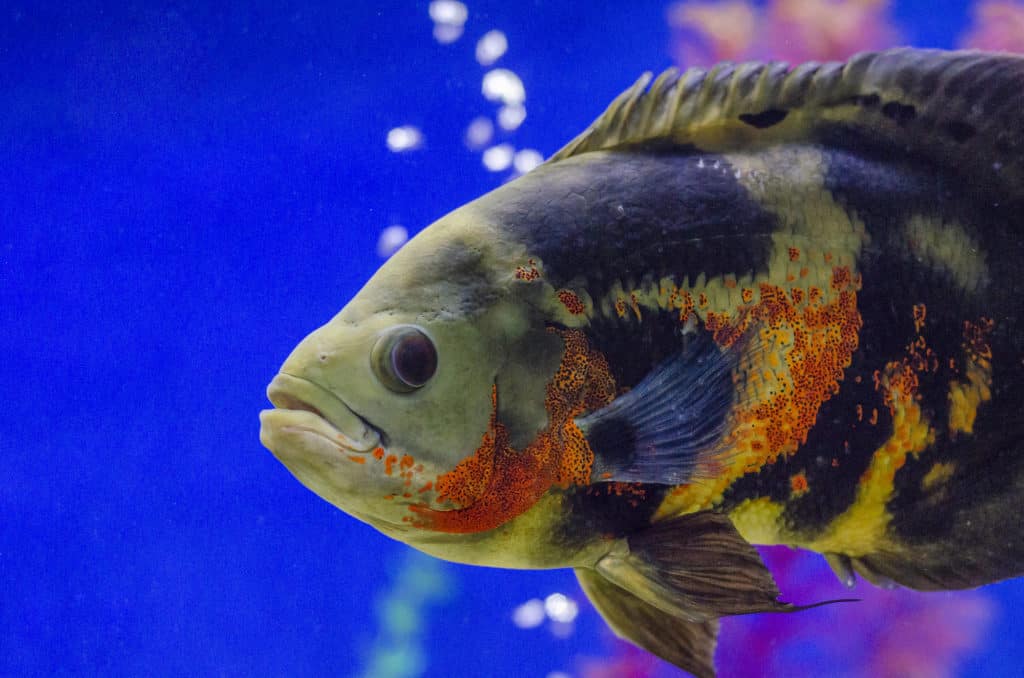
Some hobbyists love to keep peaceful and docile fish while others long for predatory fish with aggressive behaviors.
Feeding these predators is fun, and some varieties are gorgeous.
Plus, most of them are giant creatures that live way longer than smaller fish.
You can enjoy them for a long time in your aquarium.
Top 20 Most Aggressive Freshwater Fish

Here’s a list of the 20 most aggressive freshwater fish and their characteristics.
1. Dovii
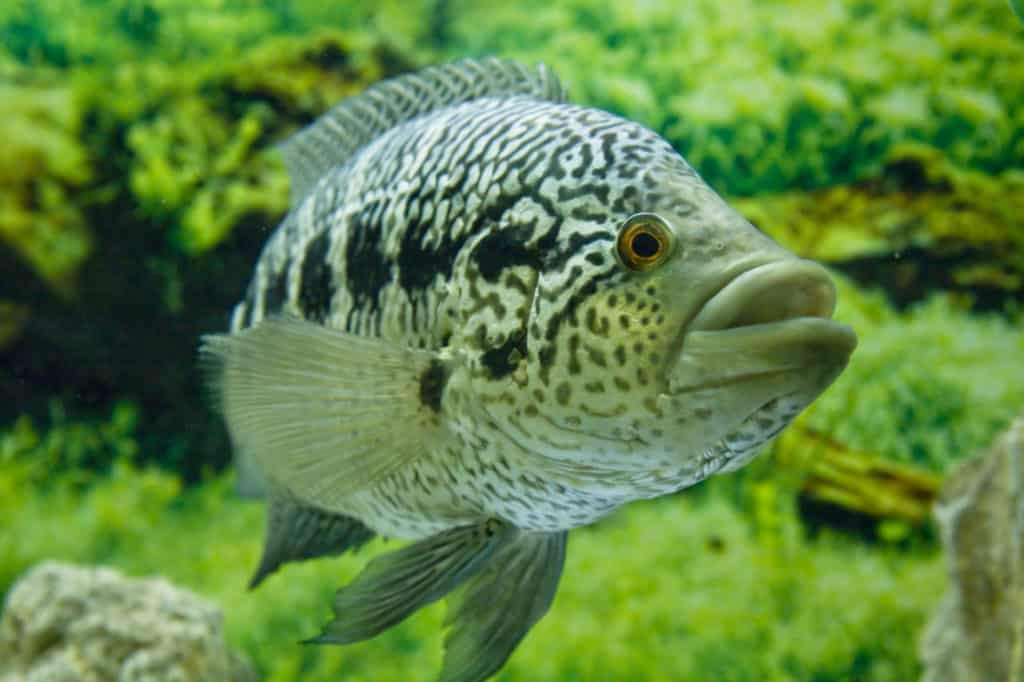
Many of the Cichlid varieties are aggressive freshwater fish, but the Wolf Cichlid or Dovii is the most hostile one.
It’s definitely not suitable for community tanks since it’ll kill any fish that isn’t strong enough to stand its ground.
With their muscular bodies and large teeth,
Dovii fish are extraordinarily predatory and will eat anything that fits into their mouths, so they’re best kept alone or as a pair.
They get even more aggressive when mating.
You may be able to keep them with other similar-sized aggressive Cichlids when they’re still juveniles, but soon, they’ll get big and start targeting other fish one by one.
They’ll grow up to 28 inches very fast, so you should be prepared to provide a very large tank or transfer them to a pond.
Despite their violent nature, they still need some hiding places like caves and stones and a deep sandy substrate.
They’re highly intelligent and territorial fish and may even consider some of the room outside their tank as part of their territory.
2. Red Devil
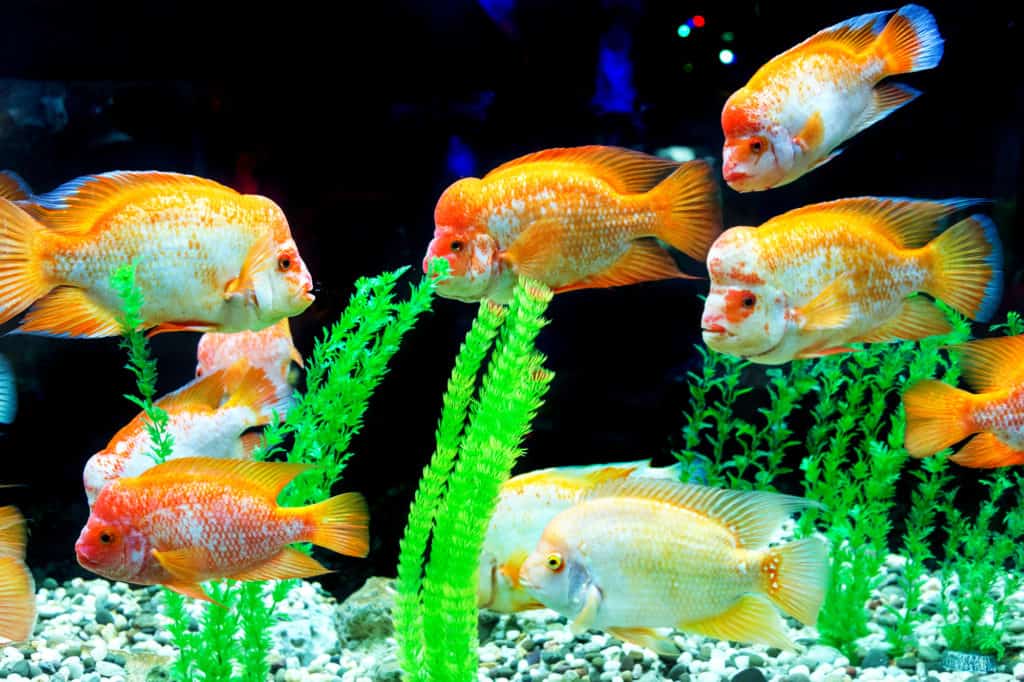
Red Devil Cichlids are charismatic fish that bond with their owners very well and even watch you approach their aquariums.
You may have some success in keeping them with tankmates when they’re still young, but they can get as aggressive as they mature—just like the Wolf Cichlid.
They grow up to 15 inches in size, and you should provide 50 gallons for each Red Devil.
The only way you can prevent other fish from getting attacked is to set up multiple caves in a large tank, so your Red Devil Cichlid can define a territory for itself.
The Red Devil probably won’t attack other fish if they stay away from its space, but no one can guarantee that!
These intelligent fish mostly come in red colors, but you can see them in white, orange, yellow, and brown.
Red Devils are known for knocking down decorations and plants, so be sure to install them correctly to prevent them from falling on your fish.
3. Flowerhorn Cichlid
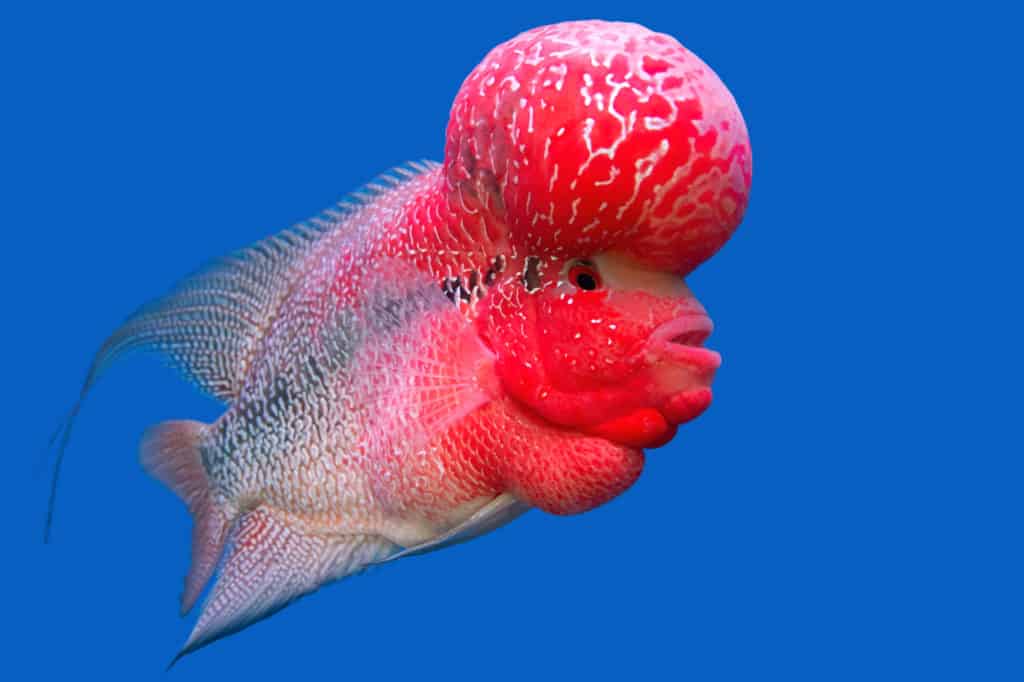
These beautiful creatures are hybrids of various Cichlids and are bred for their looks and personalities.
Flowerhorn Cichlids are popular amongst hobbyists because they’re interactive and playful fish, which may even expect you to pet them once you’ve bonded!
Their most noticeable feature is the nuchal humps, which are bigger in the males.
They come in different sizes and colors, but all are aggressive.
Some can get along with other types of Cichlids or even other aggressive fish varieties, but some can’t.
Flowerhorns are omnivorous fish, meaning that they can eat both plants and meat.
They usually eat any decorative natural plants you put in the tank, so it’s best to use rocks and caves as decorations.
They tend to bond with their owner better If they don’t have tankmates and stimulating decorations.
4. Jaguar Cichlid

Jaguar Cichlids or Managuense Cichlids get their names because of their attractive patterns.
They have cream or yellow bodies with black spots and lines, much like a jaguar.
What makes them even more interesting is that their patterns change as they grow until they reach full maturity.
Jaguar Cichlids are aggressive fish, and they’ll try to eat any smaller creature, including fish and invertebrates.
If you manage to offer them optimal living conditions and food, you may be able to house them with other fish varieties with the same temperament and size, like Cichlids or Catfish.
However, they can easily pick fights with any fish that crosses their territories and even kill them.
They can’t be tankmates with other Jaguar Cichlids unless they’ve been raised together or if they’re a couple.
Males can kill an unfamiliar female without hesitation, especially if they outgrow it.
It’s best to buy either one Jaguar Cichlid or a pair that have successfully bonded.
You should provide your Jaguars with rocks, caves, and deep substrates because they love to dig in and investigate!
5. Mini Dovii
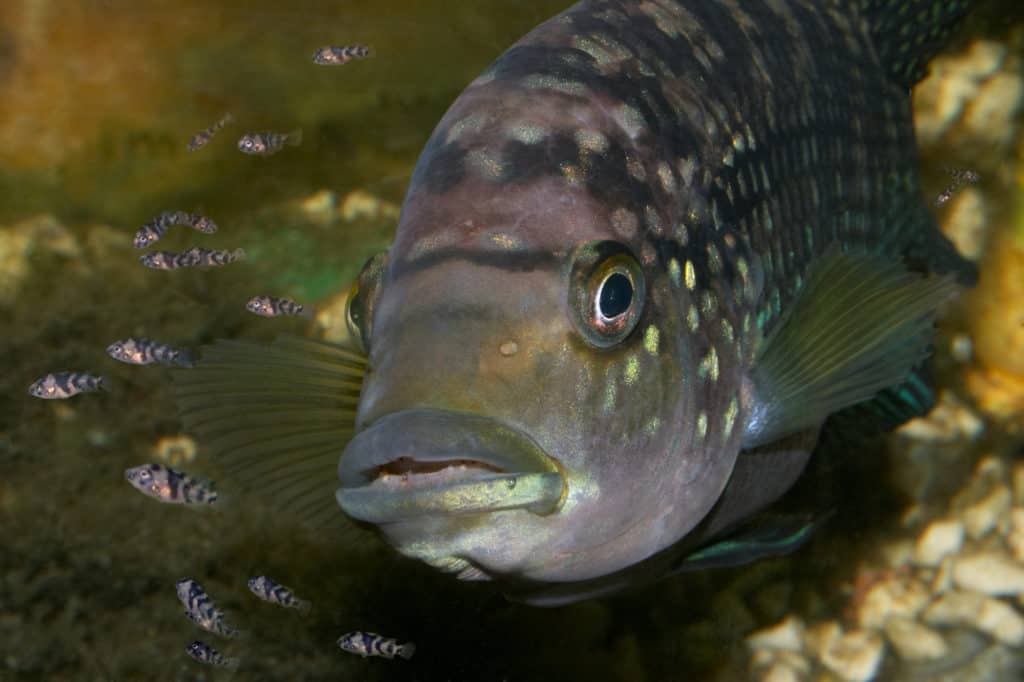
Mini Dovii or Sieve Cichlids aren’t closely related to Dovii or Wolf Cichlids.
They get their names because of their similar aggressive behavior.
They grow up to 12 inches slowly, which is half the size of a real Dovii.
They have large heads with red spots on their dark bodies.
Much like Wolf Cichlids, they’re highly territorial and can’t tolerate other fish in their space.
They get much more aggressive when mating.
If you want to keep them in a community tank with other similar-sized durable fish, be sure to keep them separate from their species since the sight of another Mini Dovii can trigger breeding behavior.
They need decorations like rocks, caves, and a substrate they can dig in.
They won’t eat the decorative plants, but they may pull out any plant that isn’t attached to rockwork or driftwood.
6. Tiger Barb
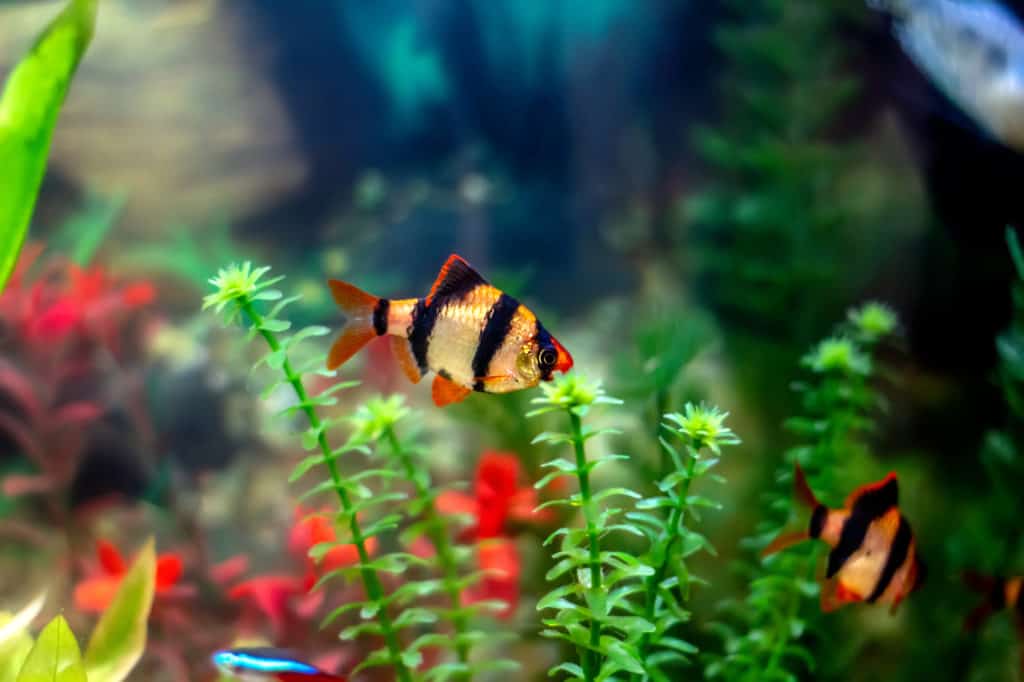
Tiger barbs are attractive fish with their orange colors and black stripes, resembling a tiger.
They can reach three inches in size.
If you keep one Tiger Barb or groups of two or three, they can get quite aggressive towards other species and wipe out your entire aquarium in the blink of an eye.
Fortunately, they’ll leave others alone if you keep them in larger groups, ideally half a dozen or more.
You shouldn’t house them with fish that have longer fins like bettas or Angelfish because they’ll chase them and nip at their flowing fins.
Slow-moving and docile fish varieties can’t survive in their tanks, either.
Besides keeping them in larger groups, adding plants and decorations while keeping the water parameters at a proper level will reduce their aggressive behavior.
In these conditions, their ideal tankmates are clown loaches, danios, platies, and catfish.
7. Arowana
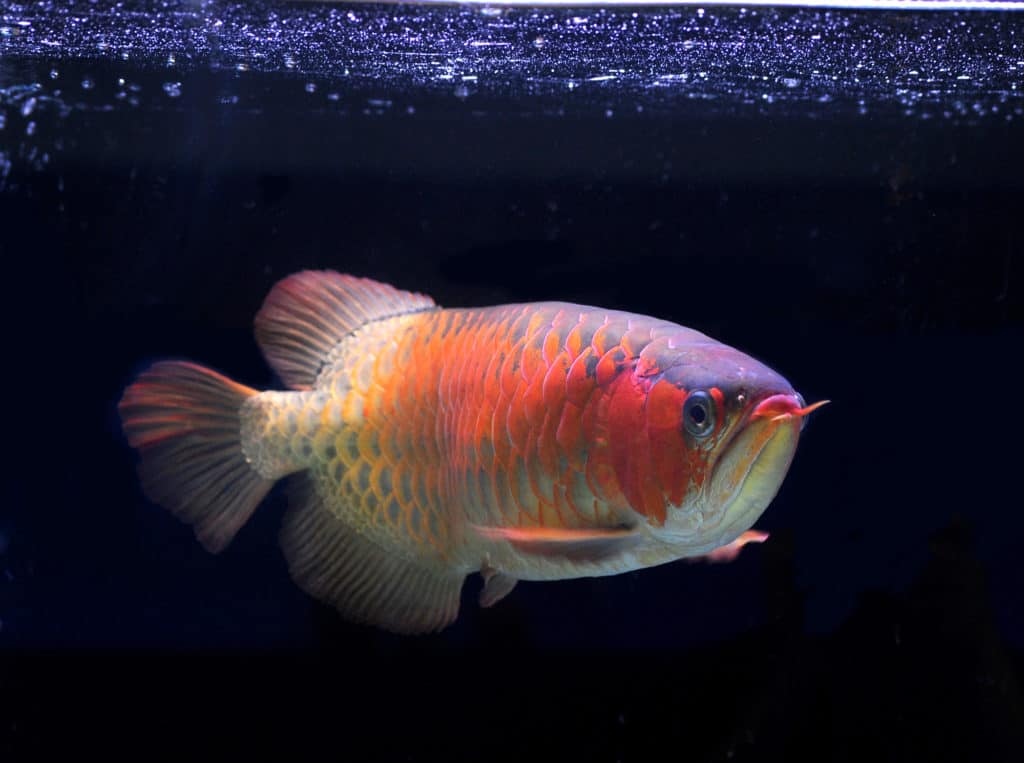
Arowanas or Dragonfish are among the most popular fish because some Asian cultures believe they bring luck.
They come in different colors, and most are very expensive.
They’re also hard to care for because of their natures.
For instance, the silver Arowanas will reach three feet in size, and providing a large enough tank isn’t affordable for some fish keepers.
Arowanas are aggressive predators and will devour smaller fish with their strong jaws if they get hungry.
It’s hard to find them good tankmates and keep them safe, so most owners decide to house their valuable fish alone or with the same species.
Arowanas are highly active and move very gracefully with their long and slender bodies, unlike any other fish.
8. Bucktooth Tetra
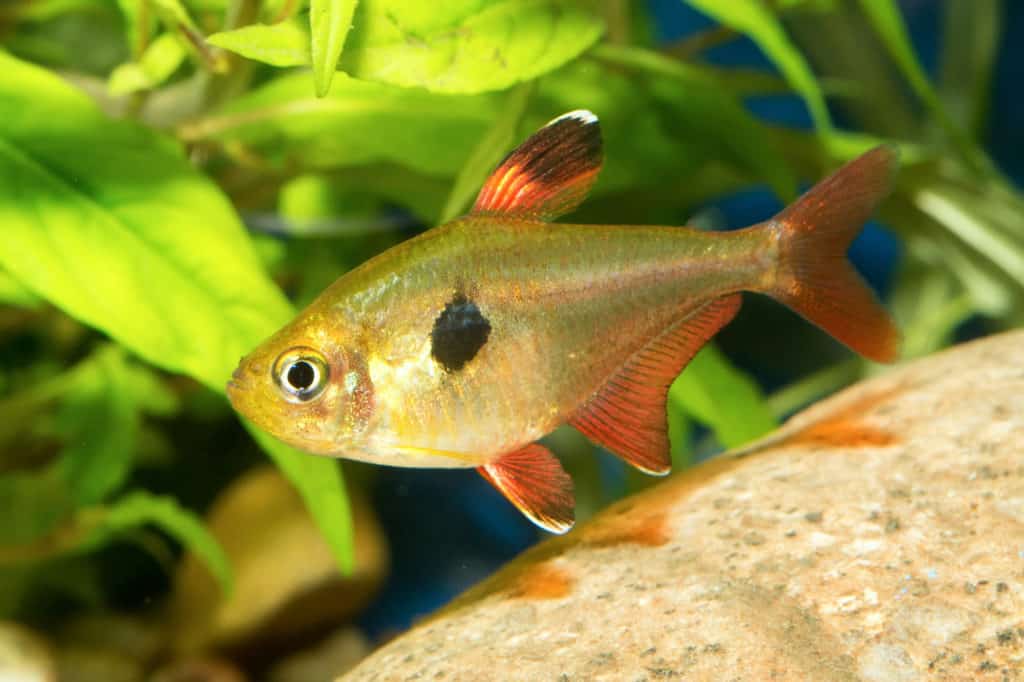
Despite being members of the Tetra family, Bucktooth tetras are highly aggressive, not only towards other species but also their own kind.
The Bucktooth tetra or Exodon Paradox has a silver body with yellow and red splashes on the body and fins.
It also has two black dots, one on its body and another on its tail.
If you keep Black Tooth Tetras in large groups, they stop fighting among themselves.
You need to keep at least six of them for that to happen.
Sometimes, you might even need eight or ten to do the trick.
They grow up to three inches, so keeping them in large numbers shouldn’t be a problem with a decent sized heavily planted tank and some decorations.
Unlike Tiger Barbs, no matter how many of them you keep in a community tank, they’ll attack and kill any other fish varieties.
With their sharp teeth, they’ll directly attack other fish without hesitation.
9. Oscars

Oscars, also known as Velvet Cichlids, are beautiful but aggressive fish.
Most of them have black or dark brown bodies with unique orange or red patterns.
They grow up to 1 foot rather quickly, and any tank smaller than 55 gallons can increase their aggressive behavior.
They’re rather popular since they bond with their owners really well, but they’re highly territorial and can turn into bullies if housed with the wrong tankmates.
Any small and vulnerable fish or invertebrate is off the table when it comes to Oscars because they’ll eat them in a bite.
It is possible to keep Oscars with other large and passive fish that can stand their ground.
Some examples are other Cichlid varieties, big catfish, Bichirs, and Silver Dollars.
The best option is a species-only tank for Oscars, as they can get along with their own kind well if you provide them with enough space and the right tank conditions.
It’s best to put caves and plants in the tank, but you should nail everything down because Oscars can dislodge or uproot them.
Provide a sandy substrate as they spend some time digging in search of food.
10. Jack Dempsey

Jack Dempsey is a member of the Cichlid family, so you can probably guess it has aggressive behavior.
It gets this name because of its strong facial muscles and behavior, resembling the boxer, Jack Dempsey.
Jack Dempsey Cichlids are mostly gray or black, with beautiful spots all over their bodies, ranging in color from yellow and green to blue and purple.
Besides their attractive appearance, they’re easy and intelligent creatures.
Nevertheless, you should be very careful when housing them with other fish.
They see small fish and invertebrates like shrimps as snacks, and they’ll bully peaceful and docile fish, maybe even to death.
The best and easiest option is to keep them with other Jack Dempsey fish, though you should be careful with the males.
Keeping one male per tank is the optimal choice.
You can also keep them with other Cichlid family members, and same-sized fish with similar temperament, like Bichirs, Angelfish, Silver Dollars, and Clown loaches.
If you do so, be sure to provide lots of hiding spots like caves and rocks to reduce aggressive behavior.
Once Jack Dempsey defines a territory for itself, it’ll spend time hiding there and usually stops harassing other fish.
They also love digging into the substrate and may knock off smaller decorations along the way.
11. Redtail Shark
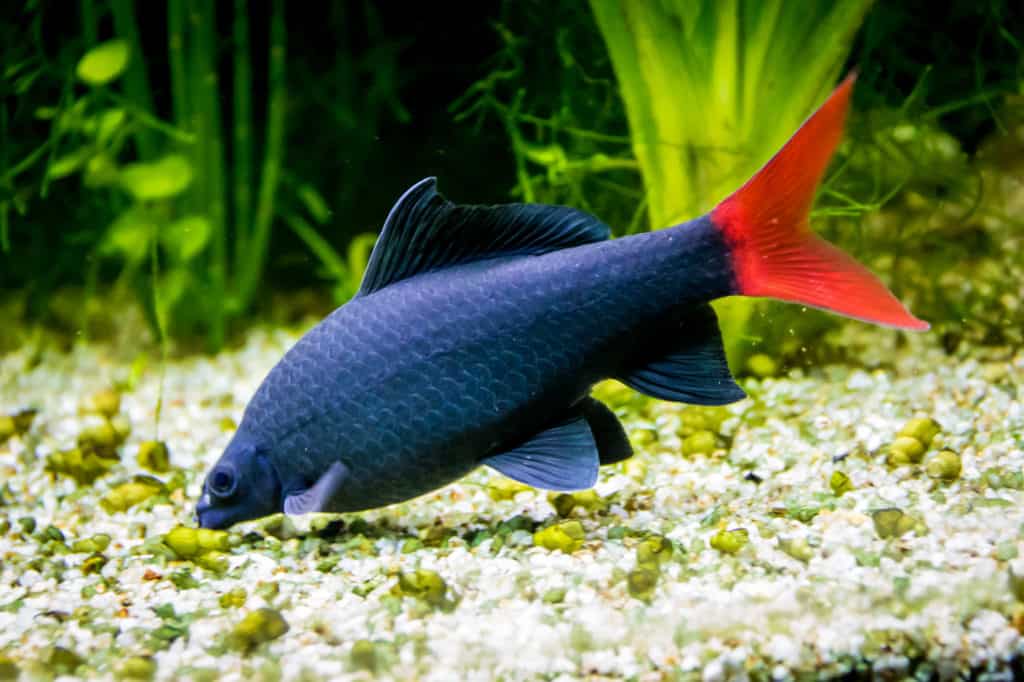
Redtail Sharks have a fairly simple but elegant look.
They’re completely black, and as their name suggests, they have a bright red forked tail.
As juveniles, they’re quite shy, and you’ll find them hiding most of the time, but as they grow, they’ll become more and more territorial.
They won’t attack or bite other fish, even smaller ones, but if anyone invades their space, they’ll chase them to the point of exhaustion.
They also get quite aggressive during feeding time.
Other fish may die because of stress, exhaustion, or malnutrition.
If you want to keep them in a community tank, be careful with your selection and house them with fast-moving and robust fish like Tetras, Danios, Gouramis, Angelfish, and Barbs.
Provide lots of caves and hiding spots in your aquarium.
Don’t keep Redtail Sharks with other shark species like the Red-finned or Rainbow shark.
Avoid housing them with red-colored fish, as it can raise disputes.
Redtail Sharks are bottom dwellers, and you’ll see them feeding on algae.
They spend most of their time at the bottom of the tank, so it’s best not to keep them with other fish species that do the same, like Cichlids, Catfish, or Plecos.
12. Vampire Fish

The Vampire fish or Payara is one of the most aggressive fish on this list and very hard to care for.
They have giant teeth, much like fangs, which is why they’re named this way.
Vampire fish are predatory and aggressive towards almost all kinds of fish.
They’re even famous for attacking fish that are bigger than them.
Your only option is to keep them with large and aggressive fish, like large Catfish or Pacu. Keep in mind, however, that they won’t live long in crowded environments.
Keeping Vampire fish alone is an option many fish keepers take, but they can get lonely and nervous and even hurt themselves.
The best way to keep them is in groups of six or more, but because they grow up to 12 inches, you’ll need a huge tank.
If you house them with only two or three Vampire fish, they may attack and hurt each other.
Vampire fish only live up to two years in captivity, they’ll only accept live food, and they’re not happy alone or in a crowded tank.
It seems like they really belong in the wild.
13. Ornate Bichir
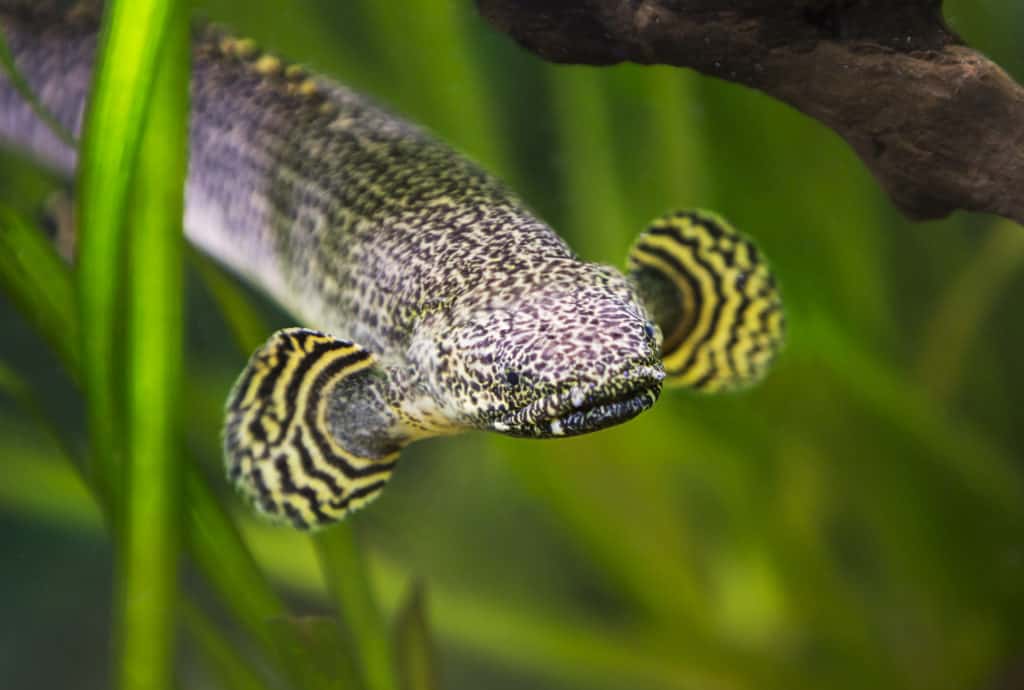
Unlike most Bichirs, the Ornate Bichir is an aggressive variety.
They can be unique and exciting additions to your tank, but you should be careful with selecting tankmates.
Bichirs have been living in freshwater for a very long time.
They look like a combination of fish and eel with triangular fins.
They’re carnivorous bottom-dwellers, so if you house them with other bottom-dwellers, they’ll get aggressive.
They can also get violent with their own kind, and they’ll eat any creature that can fit into their mouths.
The best option is to keep them with large fish that spend time in the aquarium’s middle or upper levels.
A sandy substrate is also essential since Bichirs can injure themselves on gravel while scavenging for food.
14. Red-Bellied Piranha
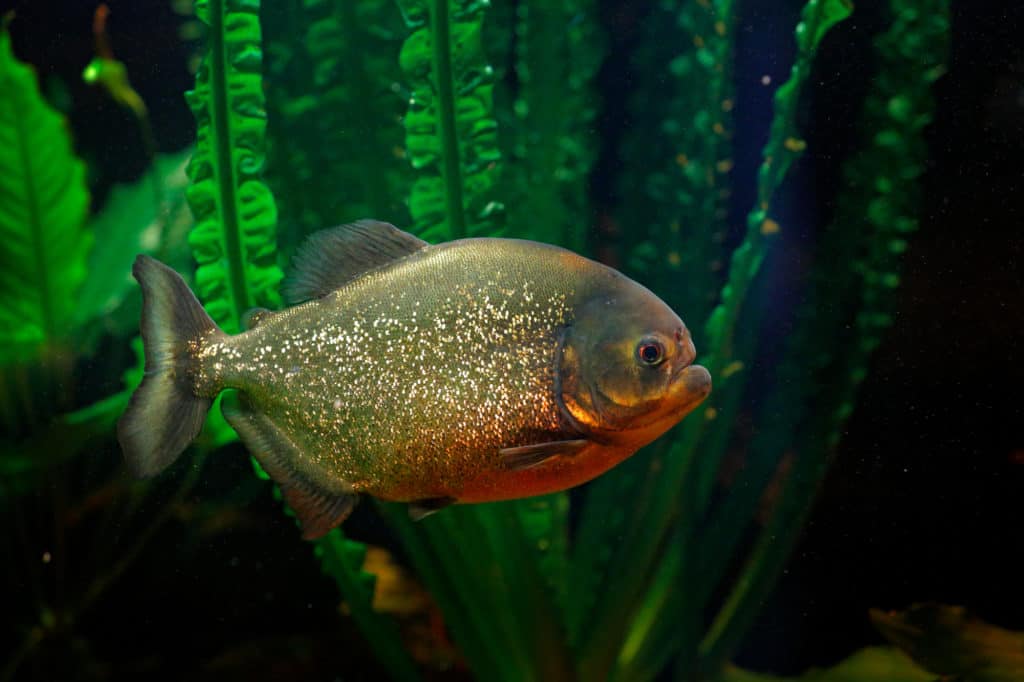
The Red-bellied Piranha is the most aggressive member of the Piranha family.
They’re mostly kept in groups, and they can attack and eat bigger fish or animals when there’s a number of them present in the tank.
They’re omnivorous fish, and they scavenge for food in the wild, but they’ll become aggressive and attack live animals with their triangular teeth and strong jaws in the dry seasons.
You can feed them with dead fish, pellets and flakes, and even vegetables and nuts.
Just remember to feed them regularly and don’t starve them because they can even attack and eat each other when facing extreme hunger.
15. Angel Fish
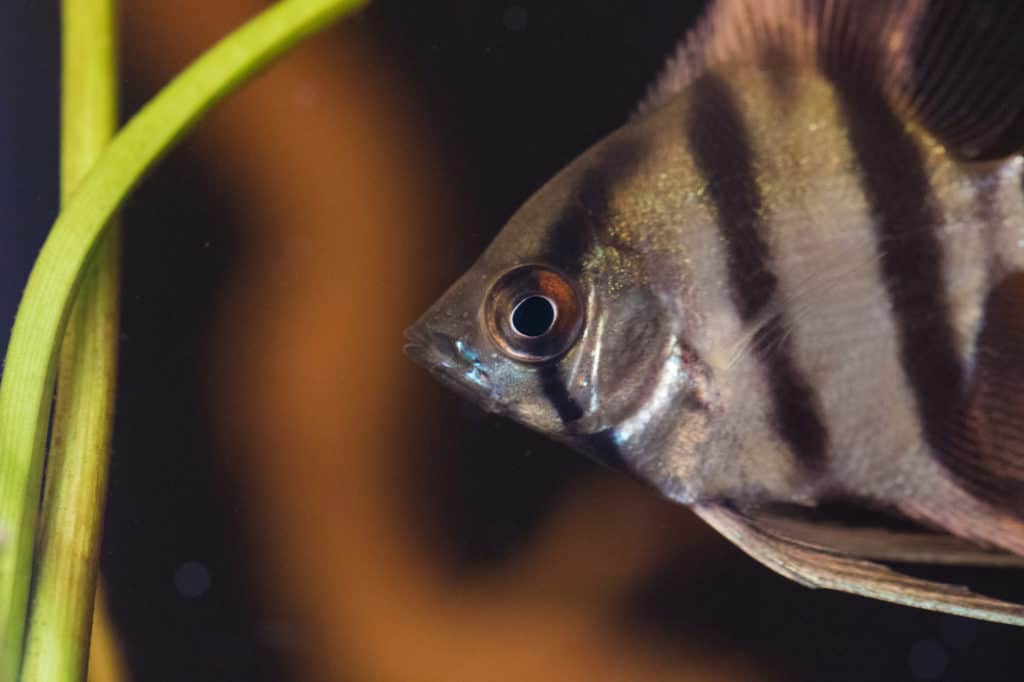
Angelfish are popular amongst hobbyists because of their black and white colors and long delicate fins.
They’re Cichlids, so aggressive behavior isn’t surprising.
They’re territorial fish, and as adults, they’re always picking fights with their own kind.
They define their territory and their rank among other angelfish with their urine and waste.
After every water change, the effects become diluted, and you may see quarrels between them, so they can regain their positions.
Generally, Angelfish can’t tolerate any competition in the tank, so they may start fights with other similarly aggressive fish varieties.
When it’s breeding time, an angelfish pair can get very defensive.
Angelfish don’t like to fight for food, and if they get hungry, they’ll eat smaller fish.
16. Goliath Tiger Fish
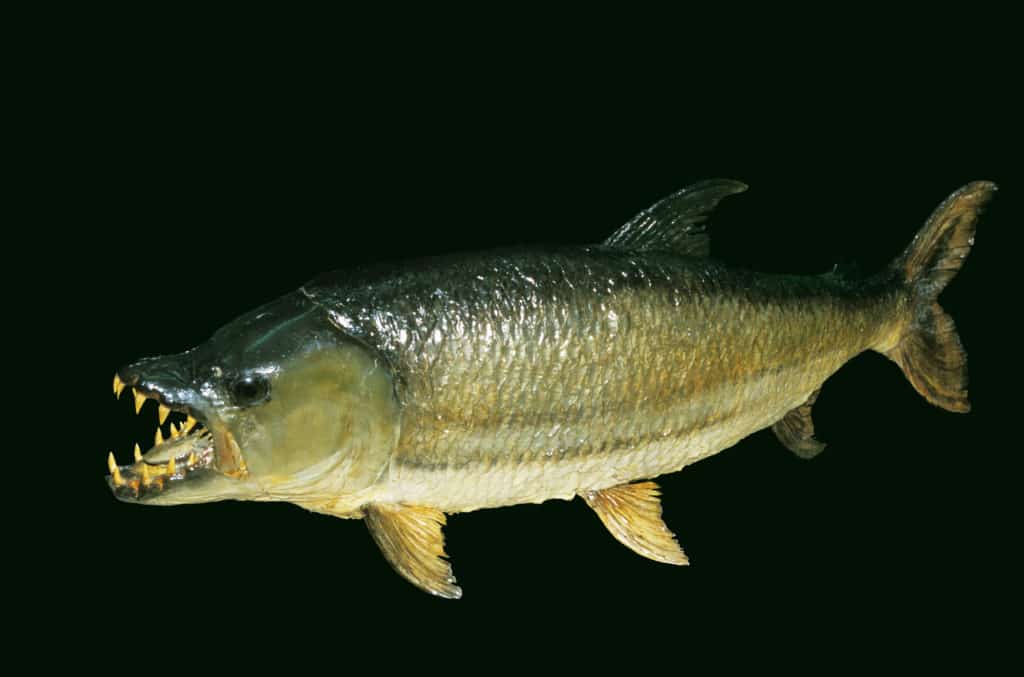
Goliath Tiger Fish are monstrous and intimidating fish, with sharp and big teeth resembling daggers.
They’re highly aggressive and predatory freshwater fish that grow up to 48 inches.
Therefore, they need enormous aquariums or ponds.
Goliath Tiger Fish will rip apart any fish in the tank without hesitation.
They may even kill and eat bigger fish. Some fish owners house them with other predatory fish while they are still young, but as an adult fish, you can’t expect any fish to survive in their presence.
17. Hoplias Aimara

The Hoplias Aimara or the Wolffish Aimara isn’t common in aquariums because it’s rare, expensive, and hard to maintain.
It reaches 30 inches in size, and it needs a large tank to thrive.
Hoplias Aimaras aren’t usually considered pets, and only professional hobbyists keep them if they want a very aggressive predator.
They’ll attack anything smaller than themselves and hold them with their sharp teeth. Aimaras even bite their owners.
The only possible tankmates are large and highly aggressive fish, but it’s not that wise to risk the lives of your valuable fish for the sake of filling your aquarium.
18. Afer Knife
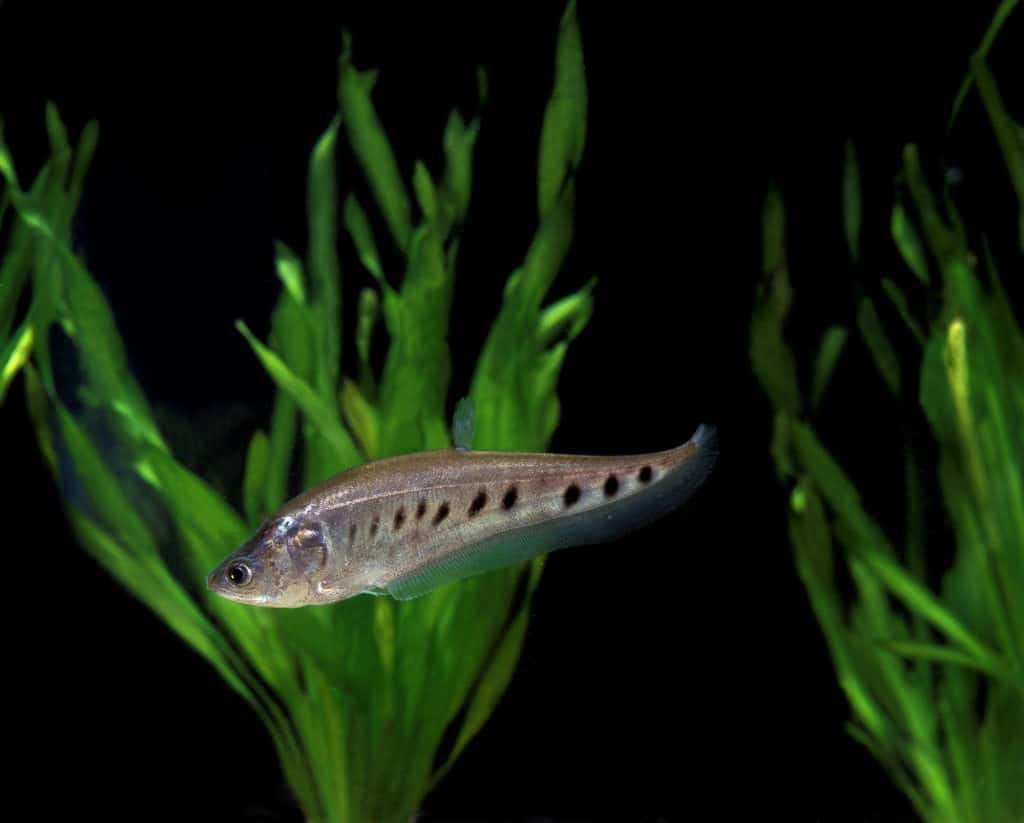
Afer Knife is the exception of the Knifefish family.
Most of them are rather shy and hide all the time, but the Afer Knife is very aggressive.
Although they still need hiding spots and plants, they’ll viciously attack most other fish in the aquarium when they reach the stage of maturity.
They’ll consider any smaller creature as food, and they even attack their own kind because of territorial disputes.
Afer Knives can grow up to 30 inches, and they need a custom-made tank.
You may be able to keep them with other large and aggressive fish like Arowanas and Cichlids, but there’s no guarantee that the Afer Knife won’t attack them.
19. Betta Fish

Betta Splendens, or Fighting fish, are popular aquarium fish because of their rare colors and beautiful, long fins.
They’re known for their natural aggressive behavior towards their own kind, and sometimes other fish.
Male bettas can’t stay in the same tank because they’ll fight to the death over food, territory, or mates, especially in a small aquarium.
They’ll also attack any fish that resembles a betta.
They usually don’t like other colorful fish and may pick fights with them.
Sometimes they attack other fish regardless of their appearance.
Some hobbyists have managed to keep bettas in peaceful community tanks, but this depends on their aggression levels.
20. Pea Pufferfish
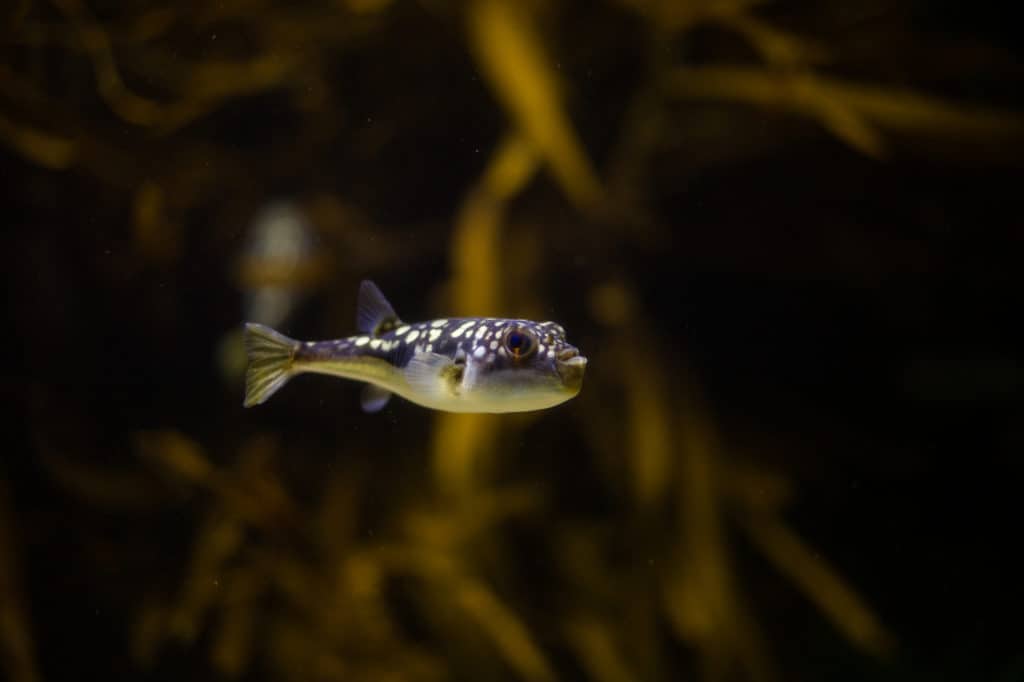
Pea Pufferfish or Pygmy Pufferfish are very cute and small, as they grow up to 1.5 inches only.
You shouldn’t let their size fool you, however, because they’re highly territorial and aggressive.
Fortunately, they get along with their own kind very well, and it’s best if you keep them in a group, provided you give them enough space.
If you attempt to keep them in community tanks, problems will arise.
You may experience a peaceful tank for a while, but after some time, smaller fish will suddenly die, and you’ll notice chunks of flesh missing from larger fish’s bodies and fins.
Pea Puffers aren’t afraid to attack bigger fish, and they’ll bully them until they leave their territories.
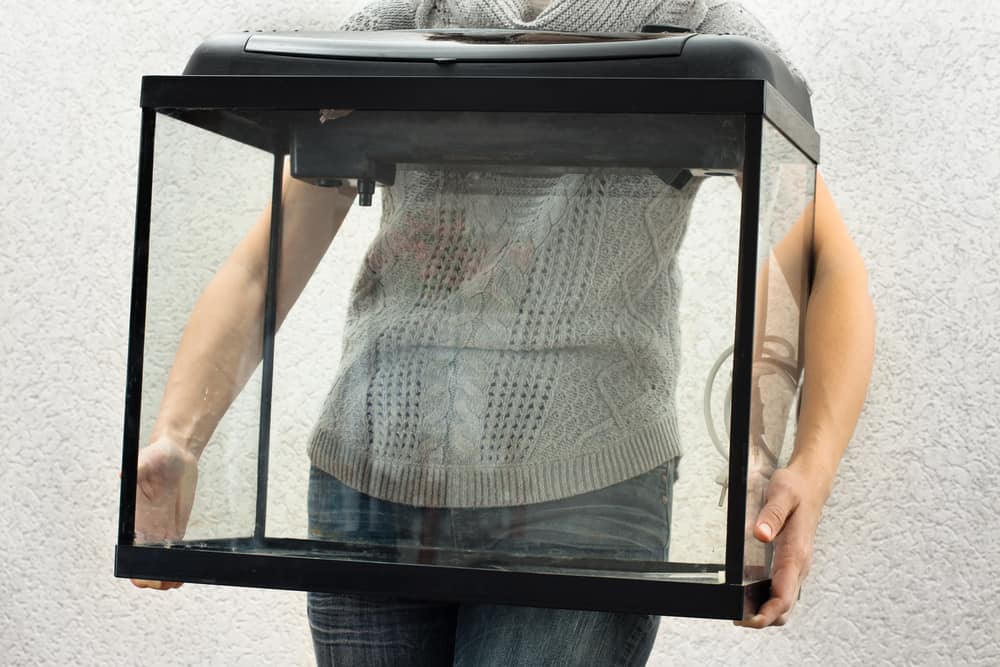

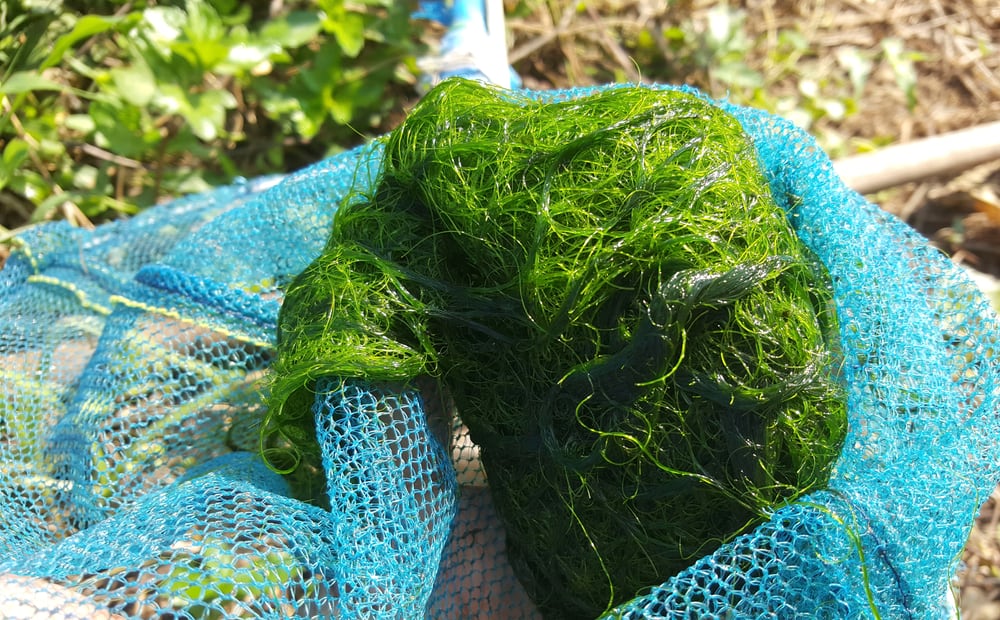
What about the Eye Biter